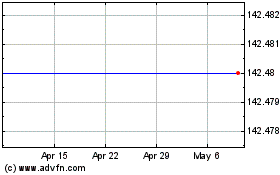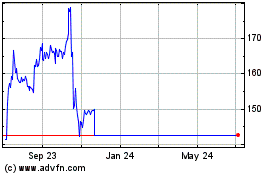Dell Shifts Tack With IPO Talks -- WSJ
September 24 2018 - 3:02AM
Dow Jones News
PC maker engages with banks after less conventional go-public
plan faces resistance
By Cara Lombardo and Dana Cimilluca
This article is being republished as part of our daily
reproduction of WSJ.com articles that also appeared in the U.S.
print edition of The Wall Street Journal (September 24, 2018).
Dell Technologies Inc. is exploring the possibility of launching
a traditional IPO instead of going public through a proposed
acquisition that has met resistance from several investors.
The PC and storage giant plans to interview several banks for
underwriting roles in an IPO this week, according to people
familiar with the matter. As a result, it has postponed by about a
week a roadshow to sell the takeover deal that was to begin this
week, the people said.
Dell would be one of the largest U.S. companies to launch an
IPO. It is far from certain that it will ultimately do so, however,
and interviewing banks could be seen as a tactic to put pressure on
investors to support the current deal.
Either way, the move is a sign tensions are rising between Dell
and investors who argue that the takeover deal undervalues its
Class V stock. Known as DVMT, that stock was created to track
Dell's controlling stake in VMware Inc., a fast-growing provider of
cloud-infrastructure services.
Acquiring DVMT would allow Dell to go public by swapping its
shares for the tracking stock. DVMT holders would receive cash too,
for total consideration of about $109 a share. But several
significant tracking-stock holders have privately balked at the
terms, with the chief complaint that Dell is overestimating the
value of its shares -- and thus underestimating the value of the
DVMT stock. Dell has said the deal is "extraordinarily fair" and
gives tracking-stock shareholders a path to invest in a broader
business.
Shareholders who are considering rejecting the current deal in a
vote that is required for it to go through include Elliott
Management Corp., Carl Icahn, some teams at BlackRock Inc., Dodge
& Cox, Farallon Capital Management LLC and Canyon Capital
Advisors LLC, according to people familiar with the matter. These
holders represent around 20% of the shares, according to
FactSet.
In a sign of the danger the deal won't go through, DVMT stock
currently trades at just over $96.
A straight IPO, in which Dell would sell shares directly to the
public and may buy out the tracking-stock holders at a smaller
premium, is seen as a backup. Even if the DVMT deal falls apart,
there is no guarantee Dell will hold a traditional IPO, which some
analysts have said would result in a lower valuation for the
company.
Last week, Dell said its current DVMT offer is final, meaning it
won't raise the price. When asked about the possibility of another
way of going public at an analyst day, Dell Chief Financial Officer
Tom Sweet said if shareholders reject the DVMT offer, the company
will "go back to status quo."
The deal on the table, which would help simplify Dell's
complicated ownership structure, was announced this summer. It was
the culmination of a strategic review the company had been
conducting for months that also looked at a straight IPO and a
combination with VMware itself.
The tracking stock was created as a way to help finance Dell's
2016 purchase of storage pioneer EMC. Dell, which was previously
public, went private in a roughly $25 billion leveraged buyout in
2013 by its founder, Michael Dell, and investment firm Silver
Lake.
Once the largest personal-computer maker, Dell is now known as
much for its corporate products such as storage, servers and
security software. It also is joining the crowded field of
companies wagering big money on the so-called Internet of Things,
as the computing giant looks for new avenues of growth amid a shift
in corporate spending to the cloud.
(END) Dow Jones Newswires
September 24, 2018 02:47 ET (06:47 GMT)
Copyright (c) 2018 Dow Jones & Company, Inc.
Vmware (NYSE:VMW)
Historical Stock Chart
From Mar 2024 to Apr 2024

Vmware (NYSE:VMW)
Historical Stock Chart
From Apr 2023 to Apr 2024
